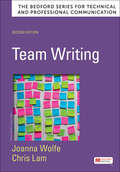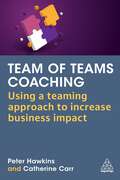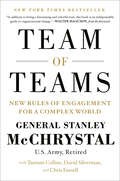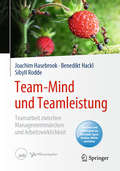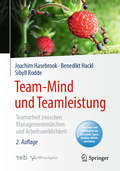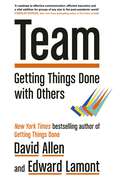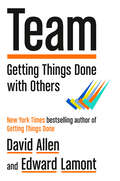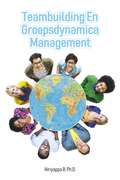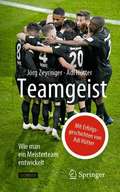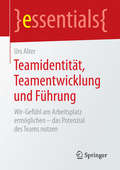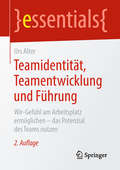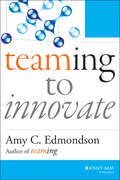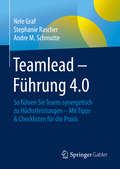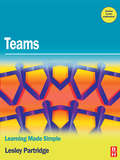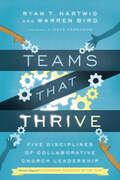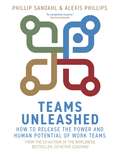- Table View
- List View
Team Writing: Bedford Series for Technical and Professional Communication
by Joanna WolfeInformed by new research into conflict management and equity in teamwork, Team Writing, 2e helps you contribute to team projects meaningfully.
Team of Teams Coaching: Using a Teaming Approach to Increase Business Impact
by Peter Hawkins Dr Catherine CarrFor an organization to be successful in the mid-21st century, it is important for all of its teams to be more than the sum of their parts and the organization's team of teams to be more than the sum of the teams. The ability to team with all stakeholders in a quick and agile manner can be a defining difference from other organizations.Written by the leading global thought leaders on teaming and systemic team coaching, Teams of Teams Coaching provides practical guidance on developing an organizational strategy and culture that delivers critical advantages. It covers the need for team of teams coaching, the benefits of this approach and how to build and implement a team of teams coaching strategy. There is also guidance on how to develop a teaming culture in the organization, building internal team coaching capacity and what to consider when exploring external coaching support.Full of global research of best practice from over seventy organizations from different sectors, as well as the authors' combined seventy years of working with coaching organizations and the team of teams, this book provides a clear map of the process to become an effective team of teams. This evidence-based guide contains methods and tools that leaders, coaches and consultants can immediately use to achieve improved performance and gain competitive advantage.
Team of Teams: New Rules of Engagement for a Complex World
by David Silverman General Stanley Mcchrystal Chris Fussell Tantum CollinsWhat if you could combine the agility, adaptability, and cohesion of a small team with the power and resources of a giant organization? THE OLD RULES NO LONGER APPLY . . . When General Stanley McChrystal took command of the Joint Special Operations Task Force in 2004, he quickly realized that conventional military tactics were failing. Al Qaeda in Iraq was a decentralized network that could move quickly, strike ruthlessly, then seemingly vanish into the local population. The allied forces had a huge advantage in numbers, equipment, and training—but none of that seemed to matter.TEACHING A LEVIATHAN TO IMPROVISE It’s no secret that in any field, small teams have many advantages—they can respond quickly, communicate freely, and make decisions without layers of bureaucracy. But organizations taking on really big challenges can’t fit in a garage. They need management practices that can scale to thousands of people. General McChrystal led a hierarchical, highly disciplined machine of thousands of men and women. But to defeat Al Qaeda in Iraq, his Task Force would have to acquire the enemy’s speed and flexibility. Was there a way to combine the power of the world’s mightiest military with the agility of the world’s most fearsome terrorist network? If so, could the same principles apply in civilian organizations?A NEW APPROACH FOR A NEW WORLD McChrystal and his colleagues discarded a century of conventional wisdom and remade the Task Force, in the midst of a grueling war, into something new: a network that combined extremely transparent communication with decentralized decision-making authority. The walls between silos were torn down. Leaders looked at the best practices of the smallest units and found ways to extend them to thousands of people on three continents, using technology to establish a oneness that would have been impossible even a decade earlier. The Task Force became a “team of teams”—faster, flatter, more flexible—and beat back Al Qaeda. BEYOND THE BATTLEFIELD In this powerful book, McChrystal and his colleagues show how the challenges they faced in Iraq can be relevant to countless businesses, nonprofits, and other organizations. The world is changing faster than ever, and the smartest response for those in charge is to give small groups the freedom to experiment while driving everyone to share what they learn across the entire organization. As the authors argue through compelling examples, the team of teams strategy has worked everywhere from hospital emergency rooms to NASA. It has the potential to transform organizations large and small.From the Hardcover edition.
Team-Mind und Teamleistung: Teamarbeit zwischen Managementmärchen und Arbeitswirklichkeit
by Joachim Hasebrook Benedikt Hackl Sibyll RoddeWie können Teams den Erfolg von Organisationen steigern?Wann schaffen Mitarbeiter in Teams wirklich mehr als alleine? Entscheiden Teams ausgewogener als Einzelne?Führt eine gute Teamatmosphäre wirklich zu mehr Leistung?Können Roboter und Künstliche Intelligenz zu Teamkollegen werden?Aus der Wissenschaft für die Praxis gibt dieses inhaltlich breit aufgestellte Buch fundierte, richtungsweisende und praxisnahe Antworten auf Fragen zum Thema „Team“. Basierend auf aktuellen Erkenntnissen der Sozial-, Arbeits- und Neuropsychologie zeigen die Autoren an vielen praxisrelevanten Beispielen und anhand von Interviews mit erfahrenen Managern aus Spitzensport, Wirtschaft, Militär und Wissenschaft, wie Teamführung in Organisationen sinnvoll umgesetzt wird und Teams erfolgreich agieren können.Erfahren Sie, wie auch Sie in Ihrer Organisation oder in Ihrem Team die gesamte Teamleistung dauerhaft steigern können.Zielgruppen:Alle, die selbst in Teams arbeiten, z. B. Teamleiter in Dienstleistung, Verwaltung oder IndustrieMitarbeiter in teamorientierten Organisationen Vorstände und AufsichtsräteManager und TeamverantwortlicheAlle, die Voraussetzungen für Teamarbeit verbessern wollen, z. B. Strategie- und ManagementberaterIngenieure für im Team verwendete MaschinenArchitekten von ArbeitsräumenDesigner von ArbeitsumgebungenForscher an Hochschulen und in Unternehmen
Team-Mind und Teamleistung: Teamarbeit zwischen Managementmärchen und Arbeitswirklichkeit
by Joachim Hasebrook Benedikt Hackl Sibyll RoddeWie erfolgreich eine Organisation ist, wird dadurch bestimmt, wie gut die Mitarbeitenden in ihr zusammenarbeiten. Krisenzeiten machen das besonders deutlich und stellen zugleich besondere Anforderungen an die Zusammenarbeit: Krisenstäbe werden gebildet, Teammitglieder arbeiten plötzlich getrennt und virtuell, Unsicherheit durch psychische Belastungen und Cyberattacken wächst. Jenseits von Binsenwahrheiten und simplen Erfolgsrezepten gibt dieses Managementbuch psychologisch und betriebswirtschaftlich fundiert Antworten, wie erfolgreiche Teamarbeit auch in Krisenzeiten funktioniert. Sie erfahren, wie Sie Teamleistungen fördern und was Sie von Hochleistungsteams lernen können. Mit zahlreichen Beispielen aus der Praxis und in Interviews führender Expertinnen und Experten aus Industrie, Wissenschaft, Medizin, Militär und Spitzensport wird leicht verständlich und unterhaltsam erläutert, wie man Trendsetter für bessere Teamleistung wird. Das Buch ist von einem Organisationspsychologen, einem Betriebswirt und einer klinischen Psychologin verfasst und daher interdisziplinär und breit anwendbar angelegt. Es beruht auf über 15 Jahren Praxis- und Forschungserfahrung sowie topaktuellen Erkenntnissen der Sozial-, Arbeits- und Neuropsychologie. Das Buch wendet sich an alle, die in Entscheidungsgremien, Entwicklungs- und Produktionsteams oder in der Teamleitung arbeiten. Es ist auch wertvoll für Teamtrainer, Coaches, Berater sowie Designer und Architekten, die Teamarbeitsplätze entwickeln.
Team: Getting Things Done with Others
by David Allen Edward LamontA groundbreaking book about how to harness the power of collaboration and work most effectively in groups - coauthored by Getting Things Done's David AllenWhen Getting Things Done was published in 2001, it was a game-changer. By revealing the principles of healthy high performance at an individual level, it transformed the experience of work and leisure for millions. Twenty years later, it has become clear that the best way to build on that success is at the team level, and one of the most frequently asked questions by dedicated GTD users is how to get an entire team onboard.By building on the effectiveness of what GTD does for individuals, Team will offer a better way of working in an organisation, while simultaneously nourishing a culture that allows individuals' skills to flourish. Using case studies from some of the world's most successful companies, Team shows how the principles of team productivity improve communication, enable effective execution and reduce stress on team members. These principles are increasingly important in the post-pandemic workplace, where the very nature of how people work together has changed so dramatically.Team is the most significant addition to the GTD canon since the original, and in offering a roadmap for building a culture of sustainable high performance, will be welcomed by readers working in any sized group or organisation.
Team: Getting Things Done with Others
by David Allen Edward LamontA groundbreaking book about how to harness the power of collaboration and work most effectively in groups - coauthored by Getting Things Done's David AllenWhen Getting Things Done was published in 2001, it was a game-changer. By revealing the principles of healthy high performance at an individual level, it transformed the experience of work and leisure for millions. Twenty years later, it has become clear that the best way to build on that success is at the team level, and one of the most frequently asked questions by dedicated GTD users is how to get an entire team onboard.By building on the effectiveness of what GTD does for individuals, Team will offer a better way of working in an organisation, while simultaneously nourishing a culture that allows individuals' skills to flourish. Using case studies from some of the world's most successful companies, Team shows how the principles of team productivity improve communication, enable effective execution and reduce stress on team members. These principles are increasingly important in the post-pandemic workplace, where the very nature of how people work together has changed so dramatically.Team is the most significant addition to the GTD canon since the original, and in offering a roadmap for building a culture of sustainable high performance, will be welcomed by readers working in any sized group or organisation.
Team: Getting Things Done with Others
by David Allen Edward LamontA groundbreaking book about how to harness the power of collaboration and work most effectively in groups—coauthored by Getting Things Done&’s David AllenWhen Getting Things Done was published in 2001, it was a game changer. By revealing the principles of healthy high performance at an individual level, it transformed the experience of work and leisure for millions. Twenty years later, it has become clear that the best way to build on that success is at the team level, and one of the most frequently asked questions by dedicated GTD users is how to get an entire team onboard.By building on the effectiveness of what GTD does for individuals, Team will offer a better way of working in an organization, while simultaneously nourishing a culture that allows individuals&’ skills to flourish. Using case studies from some of the world&’s largest and most successful companies, Team shows how leaders have employed the principles of team productivity to improve communication, enable effective execution, and reduce stress on team members. These principles are increasingly important in the post-pandemic workplace, where the very nature of how people work together has changed so dramatically.Team is the most significant addition to the GTD canon since the original, and in offering a roadmap for building a culture of healthy high performance, will be welcomed by readers working in any sized group or organization.
Teambuilding en groepsdynamica management
by Hiriyappa BTeambuilding en Group Dynamic Management geven management, managers, teamleiders en consultants praktische richtlijnen voor het bouwen en beheren van teams. Individuen die succesvolle teams willen bouwen in de complexe, sterk onderling verbonden en wereldwijd concurrerende omgevingen van vandaag. Dit boek helpt je de theorie in de praktijk te brengen. Een effectieve teambelofte van hogere productiviteit en een groter probleemoplossend vermogen en Maximaliseer teamproductiviteit door groepsbrainstorming te stimuleren. Dit boek zal de lezers helpen met een beter begrip van het team, de reikwijdte, verantwoordelijkheden, functies, effectiviteit, groepen, dynamica, normen, ontwikkeling, typen en effectief beheer ervan in een groep. Dit boek is speciaal ontworpen voor degenen die de studenten zijn van Business, MBA, PGDM & Executives. IT-beheer, managers op het middenniveau in de managementconsultant en bedrijfsleiders, en een persoon die een teamleider wil worden.
Teambuilding: Bullet Guides
by Mac BrideAre you looking for a complete course in Dutch which takes you effortlessly from beginner to confident speaker? Whether you are starting from scratch, or are just out of practice, Complete Dutch will guarantee success!
Teamgeist: Wie man ein Meisterteam entwickelt
by Jörg Zeyringer Adi HütterAus verschiedenen Persönlichkeiten ein Meisterteam zu formen – das gehört zu den größten Herausforderungen für alle Menschen, die in Teams arbeiten, diese führen oder trainieren und motivieren. Lesen Sie in eindrucksvollem Storytelling, wie dies Teams aus dem Profifußball, der Wirtschaft und dem Gesundheitswesen schaffen. Exklusive Beispiele und wahre Begebenheiten von Adi Hütter und Jörg Zeyringer veranschaulichen Ihnen, welche Methoden und Techniken den Unterschied ausmachen. Begleiten Sie besondere Teams in ihrem Alltag, lesen Sie hochinteressante Exklusivgeschichten und erfahren Sie: was „Team“ tatsächlich bedeutet, weshalb ein gemeinsames, übergeordnetes Ziel im Sinne einer großen Idee für ein Team so wichtig ist, wie das menschliche Betriebssystem funktioniert,wie ein starker Zusammenhalt und eine besondere Mentalität in einem Team entstehen,welche Strategien Meisterteams für ihren Erfolg wählen und was sie tun, wenn es einmal nicht nach Wunsch läuft. Nutzen Sie die besonderen Erkenntnisse, die in diesem Buch spannend und anschaulich dargestellt werden, sowie den großen Teamgeist-Fragebogen.
Teamidentität, Teamentwicklung und Führung: Wir-Gefühl am Arbeitsplatz ermöglichen – das Potenzial des Teams nutzen (essentials)
by Urs AlterDr. Urs Alter veranschaulicht wichtige Zusammenhänge zwischen Teamführung und Arbeitsleistung. Dabei wird deutlich, dass Mitarbeitende ihre Identität auch in der Arbeitsrolle finden müssen, wenn von ihnen Engagement verlangt wird. Der Autor beschreibt, wie Führungskräfte dies ermöglichen können und wie eine Teamidentität geschaffen wird, die als „Wir-Gefühl“ das Verhalten im Team nachhaltig und wirksam prägt. Im Zentrum des Praxisbezugs stehen die Teamentwicklung und die Verankerung von Leitgedanken: Vision, Mission, Wertvorstellungen. Schließlich ermutigt das essentialFührungskräfte, sich mit tiefer gehenden Fragen nach Sinn und Zweck der Arbeit auseinanderzusetzen, wenn sie erfolgreich bleiben wollen.
Teamidentität, Teamentwicklung und Führung: Wir-Gefühl am Arbeitsplatz ermöglichen – das Potenzial des Teams nutzen (essentials)
by Urs AlterDr. Urs Alter veranschaulicht wichtige Zusammenhänge zwischen Teamführung und Arbeitsleistung. Dabei wird deutlich, dass Mitarbeitende ihre Identität auch in der Arbeitsrolle finden müssen, wenn von ihnen Engagement verlangt wird. Der Autor beschreibt, wie Führungskräfte dies ermöglichen können und wie eine Teamidentität geschaffen wird, die als „Wir-Gefühl“ das Verhalten im Team nachhaltig und wirksam prägt. Im Zentrum des Praxisbezugs stehen die Teamentwicklung und die Verankerung von Leitgedanken: Vision, Mission, Wertvorstellungen. Schließlich ermutigt das essentialFührungskräfte, sich mit tiefer gehenden Fragen nach Sinn und Zweck der Arbeit auseinanderzusetzen, wenn sie erfolgreich bleiben wollen. Für die vorliegende zweite Auflage wurde das essential gründlich durchgesehen und auf den aktuellen Forschungsstand gebracht.
Teaming
by Amy C. EdmondsonNew breakthrough thinking in organizational learning, leadership, and change Continuous improvement, understanding complex systems, and promoting innovation are all part of the landscape of learning challenges today's companies face. Amy Edmondson shows that organizations thrive, or fail to thrive, based on how well the small groups within those organizations work. In most organizations, the work that produces value for customers is carried out by teams, and increasingly, by flexible team-like entities. The pace of change and the fluidity of most work structures means that it's not really about creating effective teams anymore, but instead about leading effective teaming. Teaming shows that organizations learn when the flexible, fluid collaborations they encompass are able to learn. The problem is teams, and other dynamic groups, don't learn naturally. Edmondson outlines the factors that prevent them from doing so, such as interpersonal fear, irrational beliefs about failure, groupthink, problematic power dynamics, and information hoarding. With Teaming, leaders can shape these factors by encouraging reflection, creating psychological safety, and overcoming defensive interpersonal dynamics that inhibit the sharing of ideas. Further, they can use practical management strategies to help organizations realize the benefits inherent in both success and failure. Presents a clear explanation of practical management concepts for increasing learning capability for business results Introduces a framework that clarifies how learning processes must be altered for different kinds of work Explains how Collaborative Learning works, and gives tips for how to do it well Includes case-study research on Intermountain healthcare, Prudential, GM, Toyota, IDEO, the IRS, and both Cincinnati and Minneapolis Children's Hospitals, among others Based on years of research, this book shows how leaders can make organizational learning happen by building teams that learn.
Teaming Up to Win the Rail Deal at GE (A)
by Amy C. Edmondson Ranjay Gulati Rachna TahilyaniIn 2012, Nalin Jain, then head of GE aviation for South Asia, was given the added responsibility for GE's transportation business in India, including bidding for a $2.5 billion contract to manufacture, service and maintain 1,000 diesel locomotives for state owned Indian Railways (IR). The deal, which would have been "the largest deal on the planet" for the transportation business, had been under discussion for six years, and many within GE had given up hope that it would materialize, but Jain persisted. In February 2015, when IR requested companies to submit a financial bid in six months, Jain quickly built an autonomous team, sequestered from the rest of GE, with people from multiple businesses and functions. His team overcame internal resistance from people at headquarters and stiff competition to help GE win the deal by a narrow margin. Jain was then tasked with executing the deal. As many of his earlier team members had moved on, Jain hired new people and built a new diverse yet integrated team for execution, with members able to put aside their many differences, look beyond their functional silos, and focus on the project deliverables. However, 2017 brought a series of challenges. GE changed India's organization structure, making India business leaders report only to their respective global business leaders instead of reporting to both their business leaders and the India country leader. Jain's mandate was expanded to include the entire international operations of GE's transportation business. And, sub-optimal company performance forced GE to announce cost cuts of $2 billion. In the face of this turmoil, Jain wonders, "Have I created an agile team that can succeed in GE's matrix environment and deal with the internal challenges? Do the team members have the maturity and motivation required for the project to succeed?"
Teaming Up to Win the Rail Deal at GE (B)
by Amy C. Edmondson Ranjay Gulati Rachna TahilyaniIn 2012, Nalin Jain, then head of GE aviation for South Asia, was given the added responsibility for GE's transportation business in India, including bidding for a $2.5 billion contract to manufacture, service and maintain 1,000 diesel locomotives for state owned Indian Railways (IR). The deal, which would have been "the largest deal on the planet" for the transportation business, had been under discussion for six years, and many within GE had given up hope that it would materialize, but Jain persisted. In February 2015, when IR requested companies to submit a financial bid in six months, Jain quickly built an autonomous team, sequestered from the rest of GE, with people from multiple businesses and functions. His team overcame internal resistance from people at headquarters and stiff competition to help GE win the deal by a narrow margin. Jain was then tasked with executing the deal. As many of his earlier team members had moved on, Jain hired new people and built a new diverse yet integrated team for execution, with members able to put aside their many differences, look beyond their functional silos, and focus on the project deliverables. However, 2017 brought a series of challenges. GE changed India's organization structure, making India business leaders report only to their respective global business leaders instead of reporting to both their business leaders and the India country leader. Jain's mandate was expanded to include the entire international operations of GE's transportation business. And, sub-optimal company performance forced GE to announce cost cuts of $2 billion. In the face of this turmoil, Jain wonders, "Have I created an agile team that can succeed in GE's matrix environment and deal with the internal challenges? Do the team members have the maturity and motivation required for the project to succeed?"
Teaming at Disney Animation
by Amy C. Edmondson Natalie Bartlett David L. Ager Emily HarburgJonathan Geibel, Director of Systems at Walt Disney Animation Studios (hereafter referred to as Disney Animation), walked through the workspace occupied by the group he had been tasked to lead. Geibel knew he was part of a creative and magical environment. The Disney studio had created more than 53 feature animated films in over three-quarters of a century - beginning with Snow White and the Seven Dwarves in 1937 through to Frozen, released in November of 2013 and awarded the Oscar for Best Animated Feature in March 2014, the first Academy Award in that category for Walt Disney Animation Studios. In late March 2014, Frozen became the highest-grossing animated feature, worldwide, of all time. There was a period in the history of the 90 year-old studio, not so many years ago (and prior to John Lasseter and Ed Catmull's leadership), when Walt Disney Animation Studios had become more structured and hierarchical, and it wasn't always easy to work across departments to innovate. Yet the work, which involved both high-tech computer animation and creative storytelling, was more cross-disciplinary and dynamic than ever. Geibel wondered what he and Ron Johnson, whom he hired and teamed up with to re-envision the Systems group within Disney Animation, could do to improve the flow and the efficiency of the organization's increasingly technical and creative work. Geibel and Johnson had already made dramatic changes in the work structure and in the physical space to promote the effective teamwork that was so essential to producing compelling, engaging animated films. Now it was time to figure out how well the changes were working, and what further changes, if any, were necessary.
Teaming to Innovate
by Amy C. EdmondsonInnovation requires teaming. (Put another way, teaming is to innovation what assembly lines are to car production.) This book brings together key insights on teaming, as they pertain to innovation. How do you build a culture of innovation? What does that culture look like? How does it evolve and grow? How are teams most effectively created and then nurtured in this context? What is a leader's role in this culture? This little book is a roadmap for teaming to innovate. We describe five necessary steps along that road: Aim High, Team Up, Fail Well, Learn Fast, and Repeat. This path is not smooth. To illustrate each critical step, we look at real-life scenarios that show how teaming to innovate provides the spark that can fertilize creativity, clarify goals, and redefine the meaning of leadership.
Teamlead – Führung 4.0: So führen Sie Teams synergetisch zu Höchstleistungen - Mit Tipps & Checklisten für die Praxis
by Nele Graf Andre M. Schmutte Stephanie RascherDie Autoren stellen mit der synergetischen Führung das erste echte teamorientierte Führungsmodell vor und zeigen konkret, was Führungskräfte tun müssen, um ihr Team leistungsfähiger zu machen. Das Ergebnis des durch das Bundesministerium für Bildung und Forschung geförderten Forschungsprojektes benennt sechs Funktionen mit 23 Führungsaufgaben und hat Tipps für den Führungsalltag parat. Mit dieser gezielten Teamführung operiert Ihr Team in schlagkräftigen Strukturen, einem motivierenden Arbeitsklima und erzielt deutlich bessere Ergebnisse. Es wird zu einem Hochleistungsteam.
Teams
by Jennifer Jolly David Wade Ronald Recardo Charles A Mention IiiIs team-based management best for your business? Will it help your organization meet the challenges of the twenty-first century to cut production costs, increase quality and service, and compete in the global economy? his practical, immensely informative book will help you make that decision. Teams tells you:When to use teams and when not to use them. What conditions must exist for teams to be successful. Which teams are appropriate for a particular situation. How to develop teams to meet the specific needs of your organization.
Teams
by Lesley PartridgeLearning Made Simple books give you skills without frills. They are matched to the main qualifications and written by experienced teachers and authors to make often tricky subjects simple to learn. Every book is designed carefully to provide bite-sized lessons matched to readers' needs.Using full colour thoughout and written by leading teachers and writers, Learning Made Simple books build on a rich legacy of over 50 years as leading publishers helping to learn new skills and develop their talents.Whether studying at college, training at work, or reading at home, aiming for a qualification or simply getting up to speed, Learning Made Simple Books will give readers the advantage of easy, well-organized training materials in a handy volume you can refer to again and again. These titles will be promoted direct to training companies and learners, and individuals will be urged to buy them not only by college lecturers but also by trainers at work. These titles will be core stock for years to come.The books are written by experienced HR trainers and will be typeset by PK McBride (an experienced teacher and author of several Learning Made Simples himself). PK McBride has a thorough understanding of the ethos of the LMSs books and his involvement will insure that all titles have a layout and style consistent with the brand. Lesley Partridge has 18 years' experience in the writing, design and development of learning materials aimed at the management and people development market. Lesly trained in educational publishing with Jossey-Bass, Wadsworth, and the University of California at Berkley Press in the US. Her clients have included Scottish Power, BSkyB, British Gas, Crown Prosecution Service, RNIB and the BBC.
Teams That Lead: A Matter of Market Strategy, Leadership Skills, and Executive Strength
by Theresa J.B. KlineTeams That Lead: A Matter of Market Strategy, Leadership Skills, and Executive Strength strikes a balance between the current scholarly literature that exists in these fields and its impact on teams. The focus on leading executive teams makes this book unique. It provides three lenses with which to view team leadership and how those various lenses can assist in making teams more effective. The first focuses on paying close attention to the market strategy of the organization and how it should drive key decisions. The second focuses on the multiple roles of the designated leader of a team. The third focus shifts to executive teams and how to be a highly effective team player in the executive environment. Each section is grounded in theoretical and empirical evidence. How this information can then be translated into useful knowledge for practitioners and researchers follows. To make it practical, however, the book provides examples, cases, measuring tools, and questions. This book will be of interest to students and professors in MBA programs, organizational behavior, public policy, and psychology courses. Practitioners, such as consultants, facilitators, trainers, and executive coaches will also be interested.
Teams That Thrive: Five Disciplines of Collaborative Church Leadership
by Warren Bird Ryan T. Hartwig2015 Readers' Choice Award Winner
Teams That Work: The Seven Drivers of Team Effectiveness
by Eduardo Salas Scott TannenbaumIn the modern workplace, employees collaborate. Managers are expected to be effective team leaders and employees are expected to be valued teammates. But many teams struggle. Being part of a struggling team can be unpleasant, but it can also hurt your career and waste company resources. <P><P> In Teams That Work, Scott Tannenbaum and Eduardo Salas present the seven drivers of team effectiveness and the clearest recommendations on what really makes teams great. Applying the lessons they've learned from working with high-stakes, high-risk team situations to any kind of organization, they will dispel some of the most enduring myths (e.g., can you be both a star and a great team player?), feature the most useful psychological research, and share real-world illustrations of effective teams in action. Readers will find actionable, evidence-based tips for being an effective team leader, a great team member, a supportive senior leader, or an impactful consultant.
Teams Unleashed: How to Release the Power and Human Potential of Work Teams
by Phillip Sandahl Alexis PhillipsFROM THE CO-AUTHOR OF THE WORLDWIDE BESTSELLER, CO-ACTIVE COACHINGTeams Unleashed provides a map and compass for engaged, sustainable, and improved team performance. This practical approach uses the everyday language of teams to highlight what's working, and uncover what's not, and gives teams the tools to to incorporate new practices that build team effectiveness. This is an approach proven in the real world of teams since 2005 and used by thousands of teams worldwide.The steps outlined are based on the fundamentals of coaching - a powerful, repeatable process to support and empower change that makes a difference. Teams Unleashed introduces the five core competencies for working effectively with teams, describes the essential team coaching skills and provides exercises and activities to generate the important conversations that lead to new understanding and new team norms.This is a book for those who work with and lead teams: team and executive coaches, internal HR, OD and L&D professionals, and team leaders. This is an approach that gives teams a way to get clear "We are here"; the tools to design "Where we go from here"; and the structure and accountability to stay on track for team success.
